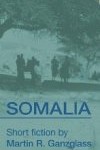Review of Martin Ganzglass: Somalia Short Fiction Collection
 Somalia: Short Fiction
Somalia: Short Fiction
by Martin R. Ganzglass (Somalia 1966-68)
Peace Corps Writers,$7.99 (paperback); $2.99 (Kindle)
356 pages
2012
Reviewed by Baker H. Morrow (Somalia 1968-69)
In this book of stories about Somalia set mostly in the sixties, Martin Ganzglass (Somalia 1966-68) works hard to give us a taste of the place: the names of the famous old hotels (the Croce del Sud and the Giuba in Mogadiscio), the nicknames that the Somalis love to hang about the necks of friend and enemy alike (Af-Chir/Mouse Mouth; Bashir Goray/the Ostrich), and gritty place descriptions (the Mad Mullah’s fort at Taleh in the North; the ruins of Mogadiscio in the nineties, the era of the warlords).
He succeeds in many ways.
His characters are Italian colonials, Peace Corps types, and local people caught up in the heady days of early independence after 1960. The problem Mr. Ganzglass wrestles with in dealing with Somalia, a notably exotic part of East Africa, is that the harder you try to grasp it the more elusive it becomes. The Middle East meets Africa here, old European colonies become new countries, and the willowy nomads of the place grin at you and then disappear into the endless acacia scrub with their grumbling camels and bleating goats. And they are not always the friendliest of people.
Maybe you deal with Somalia best in snippets, as this book does, but can you make sense of it as a whole?
One way is to work a little with the lyrical quality of the country. Here is a quote from “Galkayo,” the fourth story in the collection:
The Somali music with the drums and the oud and the nasal, plaintive love songs coming from [the] radio inside. The … sound of Somali being spoken on the streets.
Ganzglass’s characters Rich and Dave (no last names) reach for the poetic quality in Somali society and sometimes find it. But their everyday lives in the country are dangerous, complicated, and difficult. Dave, for instance, is the Peace Corps teacher in Galkayo, a hot, desolate, Northern town whose name means “Spewer of Infidels.” He doggedly tries to carry on with his eager schoolkids through a spell of debilitating double-vision.
Rich is a lawyer assigned to the Somali National Police Force, which is trained by the United States and frequently at odds with the Russian-supported Somali National Army. In story after story, Rich works to set up a penal code, advise a government ministry or two, and help the police as they become informed and impartial executors of a general rule of law.
What sort of law? An Italian civil and criminal form of justice? (Colonial southern Somalia was Italian.) British Common Law? (British Somaliland was the old colony in the North.)
Here Ganzglass is on firm ground. His own good works (and there were many of them) were a renowned high point of the efforts of the Peace Corps in Somalia in the 1960s, and he writes about Rich the lawyer with great passion. In “Habeas Corpus,” for instance, several Somali policemen are in prison for actually enforcing the new laws of the country, and Rich is trying to spring them. He needs some Scebelli River farmers, who are Bantu, to speak up in court against their neighbors, who are taller, more aggressive, Hamitic-speaking Somali tribesmen. Will it work?
“One cannot teach sheep to fight a lion,” says Colonel Abdullahi, the National Police Commandant.

Martain R. Ganzglass
Tribal politics and national birthing pains abound in this book, and Ganzglass takes great pains to explain them and to note their influence on the emergence of Somalia as a feasible country. But we see in a number of the stories that he doesn’t quite trust his people and places with the message: he will sometimes add more emphasis or repetition where none is needed. Rich and Dave, Antonio Scafuldi, and Lt. Raghe are good characters, and good messengers: he can trust them to do their job, but he seems reluctant to do so.
A few other awkwardnesses: parts of the stories are peppered with the acronyms of such local government agencies as the C.I.D., N.S.S., and E.L.F., and there is no explanation. Perhaps a glossary would help. And punctuation and typographical infelicities occasionally mar the flow of a tale.
On the whole, however, Somalia is a heartfelt and penetrating account of a country in the midst of a decade or so of great change that would now be lost to us completely without stories like these.
As I mentioned in my own Horses Like the Wind (2001), the sixties in Somalia seemed so immediate and full to anyone who was there, so bursting with import and change, that we never thought of that time as simply a fleeting moment. But that’s just what it was, and now it’s nearing fifty years ago. Ganzglass’s stories help to flesh out what the place was really like in the last century in all the ways that only fiction can.
Baker H. Morrow is a landscape architect in private practice in Albuquerque and the founder of the Master’s Program in Landscape Architecture (MLA) at the University of New Mexico. He has been the Director of the Registry of Historic Landscapes for New Mexico since 1980. The author or editor of nine books, Baker served in the Peace Corps in Somalia from 1968 to 1969. His book of African stories, Horses Like the Wind (amazon.com) was published in 2001, and he is the translator of The South American Expeditions, 1540-1545 of Cabeza de Vaca (2011, also amazon.com), which won the Publication Award (2011) of the Spanish Ministry of Culture.
Dear Baker,
Thanks for reviewing Marty’s book. I hope your comments encourage people to buy it and read it. I had reviewing the book on my to do list but your knowledge and your own writing make you much more qualified.
I thought that Marty caught the complexity of life there as will as the complexity of outsiders trying to do anything useful.
I was in Somalia doing an evaluation for the Peace Corps when the president was assassinated in Las Anod. When I returned to Mog after being in Chismayo for a few days under curfew I visited the Ministry of Education. The minster said that he would like me to ask Peace Corps in Washington for 100 more teachers. I cabled Peace Corps saying that we were about to be expelled, which is what happened. I think that Marty captures this type of complexity in his book.
I look forward to getting your book and learning from your insights.
Thanks again.
The years there were some of the most memorable, engaging and growth enhancing of my life.
John F. Fanselow, Contractor’s Overseas Representative from Teachers College, Columbia to Peace Corps Somalia 1966-1968